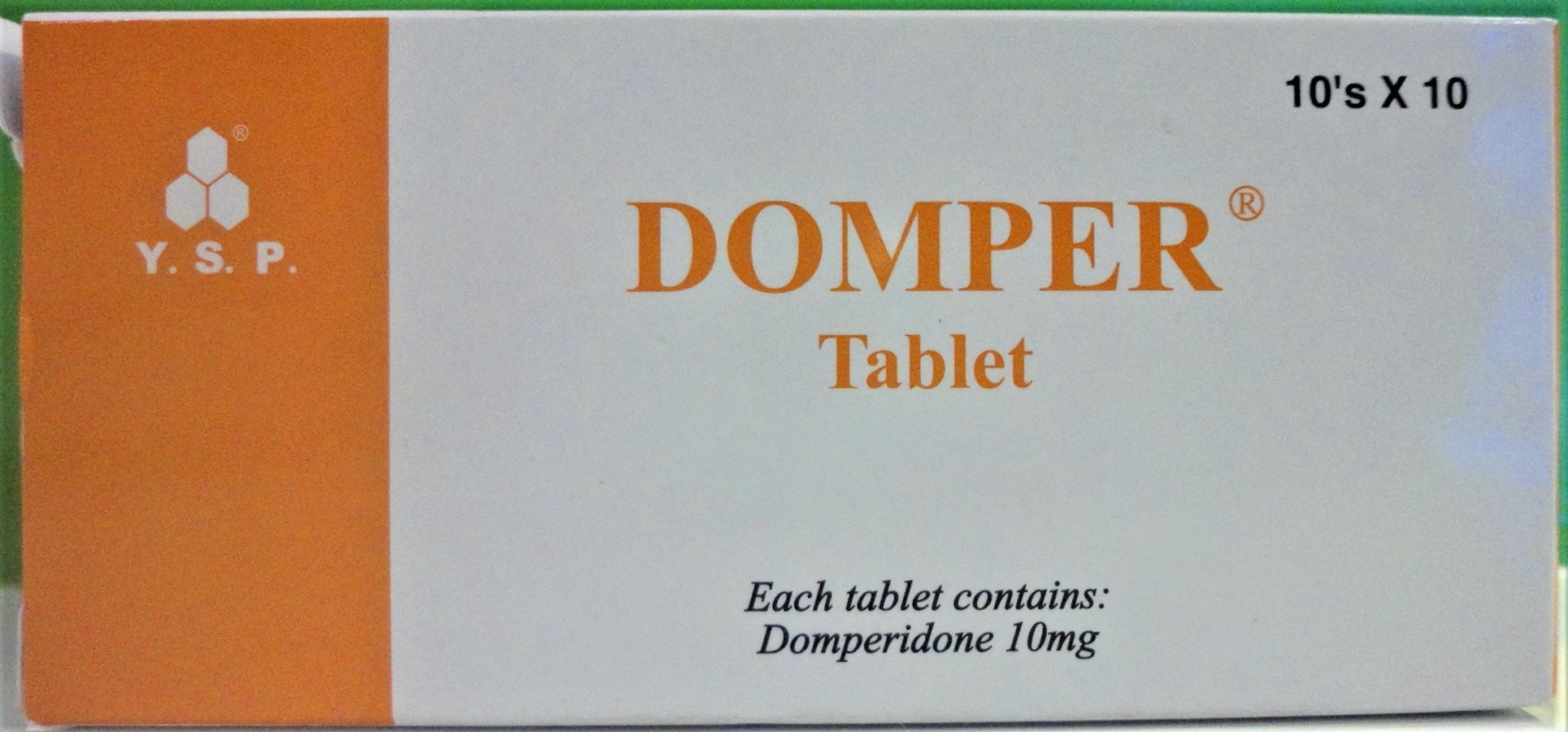DOMPER Tablet
ក្រុមហ៊ុនផលិតឱសថ:
Y.S.P. INDUSTRIES(M) SDN.BHD., Malaysia
ក្រុមហ៊ុនចែកចាយឱសថនៅប្រទេសកម្ពុជា:
INTERMEDICA


- សារធាតុសកម្ម
- ប្រសិទ្ធិភាពព្យាបាល និង កម្រិតប្រើប្រាស់
- ហាមប្រើ
- ផលរំខាន
- អន្តរប្រតិកម្ម
- ស្ត្រីមានផ្ទៃពោះ និង ស្ត្រីបំបៅដោះកូន
- ការប្រុងប្រយ័ត្នជាពិសេស
- សកម្មភាពឱសថ បរិយាយប័ណ្ណឱសថ
-
សារធាតុសកម្ម
Domperidone 10mg
-
ប្រសិទ្ធិភាពព្យាបាល និង កម្រិតប្រើប្រាស់
For the symptomatic relief of nausea and vomiting.
Dosage and Administration
The usual dosage in adults is 1 tablet 3-4 times a day.
The usual dosage for children is 0.3mg/kg body weight, 3-4 times a day.
(Oral use in child: for nausea and vomiting following cytotoxic therapy or radiotherapy only.)
Doses above 30mg/day should be used with caution due to potential risk of arrhythmias associated with the higher doses.
The dosage should be given before meals and if required at bedtime.
Maximum period of treatment is 12 weeks.
To be dispensed on physician’s prescription.
-
ហាមប្រើ
1. Hypersensitivity to any of the components in this product.
2. Should not be used in patients with gastrointestinal hemorrhage or mechanical obstruction.
-
ផលរំខាន
Domperidone is well tolerated. The side effects which have been reported are as follows:
CNS: dry mouth, headache, insomnia, dizziness, thirst.
Gastrointestinal: transient mild abdominal cramps, diarrhoea.
Endocrinologic: Domperidone may elevate prolactin level, which may lead to mastalgia, galactorrhoea or gynecomastia.
Cardiovascular: edema, palpitations. Ventricular arrhythmias and sudden cardiac death (with frequency ‘unknown’).
-
អន្តរប្រតិកម្ម
1. Co-administration with anticholinergic drugs may compromise the beneficial effect of Domperidone.
2. Care should be exercised when Domperidone is administered in combination with MAO inhibitors.
3. In vitro data suggest that the concomitant use of drugs that significantly inhibit CYP3A4 may result in increased plasma levels of domperidone. Examples of CYP3A4 inhibitors include Azole antifungals, macrolide antibiotics, HIV protease inhibitors and nefazodone.
A QTc prolongation of about 10-20 msec was observed in an interaction study for the combination of Domperidone (10mg qid) and ketoconazole (200mg bid).
-
ស្ត្រីមានផ្ទៃពោះ និង ស្ត្រីបំបៅដោះកូន
The safety of the use of this drug during pregnancy and lactation has not been established. Women who suspect of pregnancy, pregnant women, and nursing mothers should not be given this drug unless clearly needed.
-
ការប្រុងប្រយ័ត្នជាពិសេស
1. The safety of the use of this drug during pregnancy and lactation has not been established. Women who suspect of pregnancy, pregnant women, and nursing mothers should not be given this drug unless clearly needed.
2. Use with caution in patient with renal impairment.
3. Domperidone is not recommended for chronic administration.
4. Cardiovascular effects: Some epidemiological studies showed that domperidone may be associated with an increased risk of serious ventricular arrhythmias or sudden cardiac death. The risk may be higher in patients older than 60 years or at daily doses of more than 30mg. Domperidone should be used at the lowest effective dose in adults and children.
Use of Domperidone and other drugs which prolong QTc intervals requires that caution be exercised in patients who have existing prolongation or cardiac conduction intervals, particularly QTc, patients with significant electrolyte disturbances or underlying cardiac diseases such as congestive heart failure.
-
សកម្មភាពឱសថ
1. Domperidone is a selective peripheral dopamine antagonist at the D2-receptor. It acts principally at receptors in the chemoreceptor trigger zone in the stomach.
2. Domperidone effectively increases esophageal peristalsis, and lower esophageal sphincter pressure (LESP), increases gastric motility and peristalsis, enhances gastroduodenal coordination and consequently facilitates gastric emptying and decreases small bowel transit time.
3. Unlike Metoclopramide, Domperidone does not readily enter the central nervous system and has no acetylcholine-like effect at the peripheral muscarinic synapses. Therefore, it is less likely to produce central effect such as extrapyramidal reaction or drowsiness and has no effect on gastric selection.
4. Domperidone is rapidly and completely absorbed from the gastrointestinal tract. Peak concentrations occur within 30 minutes after oral administration. It is excreted in the feces and urine largely as metabolites. Domperidone is generally not considered to cross the blood-brain barrier, but some reports of central adverse reactions have been reported.
*ព័ត៌មានឱសថត្រូវបានរៀបរៀងដោយ អ៊ីម៉ាតុគឹ មេឌីក (ខេមបូឌា) ដោយផ្អែកលើប្រភពព័ត៌មានខាងក្រោម។ សម្រាប់ព័ត៌មានលម្អិត សូមស្វែងរកនៅក្នុងក្រដាសព័ត៌មាននៃឱសថនីមួយៗ ឬ សាកសួរទៅកាន់ក្រុមហ៊ុនឱសថឬតំណាងចែកចាយនៃឱសថនីមួយៗ។
ប្រភពព័ត៌មាន៖
- ក្រដាសព័ត៌មាននៃឱសថសម្រាប់អ្នកជំនាញវេជ្ជសាស្ត្រដែលប្រើប្រាស់នៅប្រទេសជប៉ុន (Pharmaceutical and Medical Devices Agency, Pmda): https://www.pmda.go.jp
- ព័ត៌មានសង្ខេបនៃឱសថសម្រាប់អ្នកជំងឺដែលប្រើប្រាស់នៅប្រទេសជប៉ុន: http://www.rad-ar.or.jp
